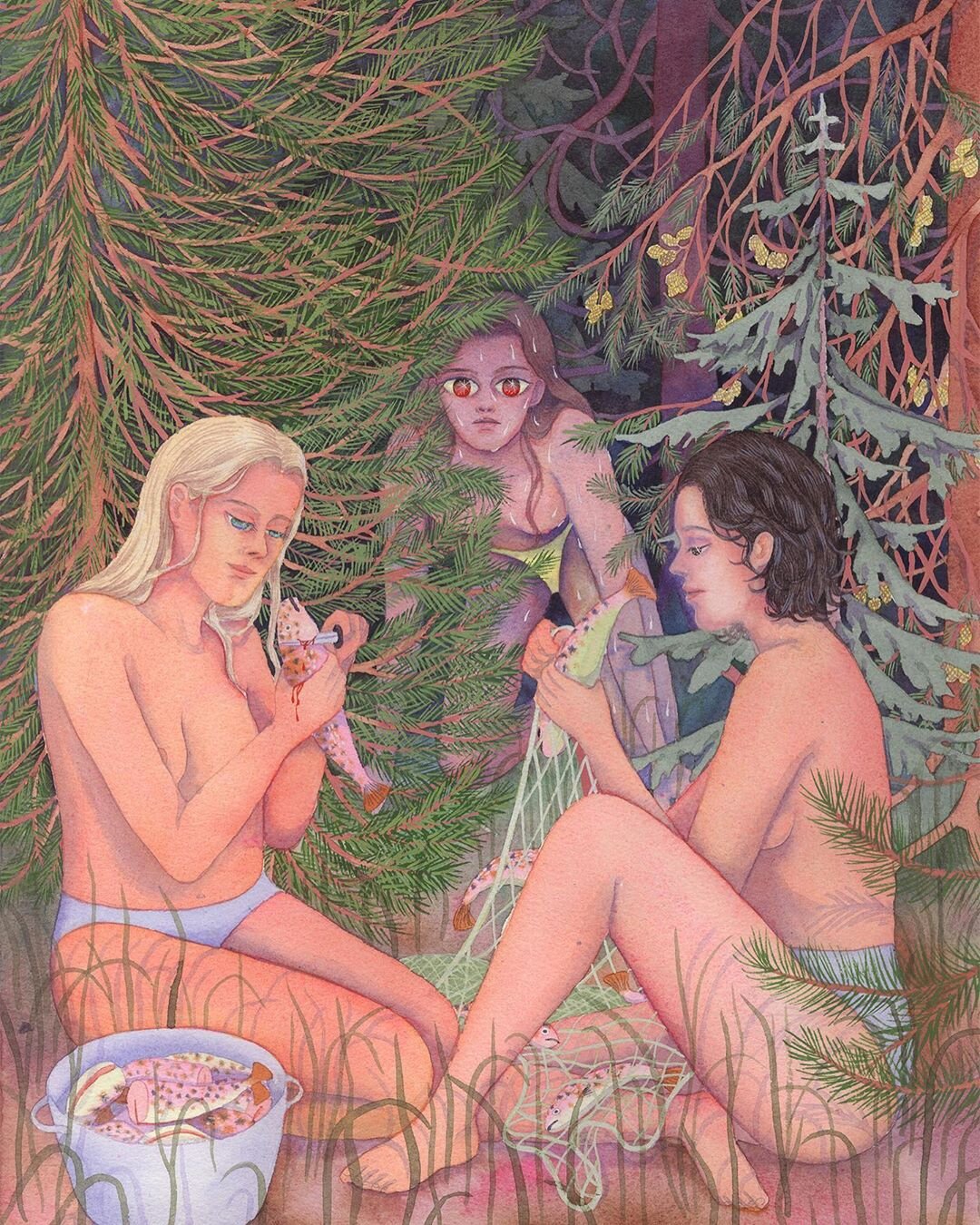Oda Iselin
Oda Iselin Sønderland’s pictorial language is built on the interplay between logical thinking and her subconscious. Her work heightens and romanticizes difficult feelings – pain, fear, the recognition of identity – through a delicate balance of decorative motifs, a refined, stylized imagery, and a looming sense of darkness. Oda explores the idea of reflection to reveal more of her characters and space that surrounds them. She interprets the concept itself as reminiscent of fundamental questions about humanity, as well as evocative of the inner child – the one who always wishes to be seen. At the core of her exquisitely detailed images there’s a perceptive gaze, an intuition and a need. Hers is a vision that echoes past obsessions and traces back to the impression left by ideals of perfection and innocence, unfolding the everlasting bond that connects power, beauty and control.
The imaginaries you portray merge reality with dream-like – at times nightmarish – circumstances. Like journeys into the subconscious, they draw a path into the lesser known depths of the psyche. However, it feels like they’re not just an exploration of a fantasy. The psychic and the carnal seem to coexist in your visual universe, as there are also elements of physical exploration that deal with anxieties and desires, which look very real. How do you build such an imaginary?
A lot of the ideas in my work comes from my intuition, an image pops into my head and I follow the need to paint it. It can start with just an element in the painting, and during the process new things get added or changed. After the painting is done, its meaning becomes clear to me and I am able to make sense out of its symbolism. It’s basically an interaction between my subconsciousness and my logical thinking. The logic takes care of technical aspects like composition, texture and color, while the subconscious gives it the content. Working this way allows for a pictorial language to express things that could be easily killed with too many words.
In your works everything is very precisely depicted. While the images are very controlled, your characters often seem to be trapped, to have no control over the unescapable situations they’re in. There is a looming sense of menace, as if bad omens were lingering in the air of a fairytale. Hazy boundaries separate the soft, pastel-toned innocence of the female characters from all the sweat, blood, and evil that saturate your images. I think the way you blur limits is very interesting. Can you speak about the sense of ambiguity in your storytelling?
It has a lot to do with heightening and romanticizing difficult feelings through stylized, beautiful imagery. There’s something painful and frightening that is insisting on its presence in work, and I decorate it with flowers. It’s hope and hopelessness in eternal conflict.
Something that instantly captured me in your work was the way you use the image within an image, as mise en abyme, and the sparkly eyeballs. In particular, I love how you bring this technique to an intimate and emotional level by situating it in the eyes of your characters – as a reflection of what is other, and perhaps of themselves too. What’s behind your fascination for the doubling or multiplying of one’s image?
I have used this effect in different ways, for different purposes. One is the reflection, as a reveal of something in the room or within the character. The idea of reflection in itself reminds me so much of just what it means to be human, and especially the inner child that is always hoping to be seen. Every idea that we have of identity is about reflection, how do others see us and how do we see ourselves. The other effect I have used is not a reflection, but a composition of two or more images/scenes in one painting. This is more of an experimentation with the construction of an image, and I use them to comment each other. I find it interesting the way the two universes are separated, while simultaneously relate to each other.
Speaking of sparkling eyes, I’d like to ask you about your interest for the magical girl genre. I used to be the biggest Sailor Moon fan, and I remember there being a lot of violence, beside the superpowers and the romance. How did you get into the genre, and how has it inspired you?
I started watching anime when I was around 12 years old, and my first one was Tokyo Mew Mew, which is a magical girl anime. I think the drama, innocence and the beauty spoke to me at the time, and I became obsessed with anime girls. I wanted to live an anime girl life. Later I have analyzed my past obsession and looked at it from an outside point of view. I have found that I am still very much affected by this idea of perfection through innocence and sweetness. The girls in these anime are very powerful, the idea of power is then attached to the idea of beauty and kindness. Beauty can therefore often give a sense of control, which is something we all look to acquire.
What are your favourite magical girls?
I have been obsessed with different anime girl characters during my life, but I can remember that the anime Princess Tutu did a big impact on me at the time. I really loved the characters Princess Tutu and Princess Kraehe. It is a very dramatic and emotional anime series about love, fate and desire, with a lot of references to fairytales.
courtesy ODA ISELIN
interview VERONICA GISONDI
What to read next


















